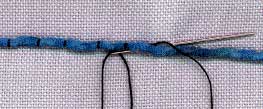Couching or Laid work

![]() Couching is also known as convent stitch and kloster stitch.
Couching is also known as convent stitch and kloster stitch.
Medieval embroiderers made full use of couching to be economical with expensive threads, such as gold thread, on the surface of the work. It is used, to this day, to attach threads which are too thick, or textured to pass through the foundation fabric. The term is from the French word 'coucher', which means to lay down.
 Couching is extremely
simple to work. Work with the fabric stretched in an embroidery hoop or
frame.
Couching is extremely
simple to work. Work with the fabric stretched in an embroidery hoop or
frame.
To commence bring the heavy thread up from the back of the fabric with a large eyed needle. The surface thread is laid on the fabric, and then anchored by a second finer thread.
Small, straight stitches are taken over the thick thread and back through the fabric. Work along the thick thread until you have completed the line.
Take the heavy thread to the back of the fabric with a large needle and secure both ends of the heavy thread by using a few small stitches. Do not clip the heavy thread too close, otherwise it will pop up to the surface of the embroidery.
The second thread can be arranged in patterns - as in laid work. Other types of couching involve using embroidery stitches such as herringbone, fly stitch, arrowhead stitch, satin stitch, detached chain stitch, buttonhole and numerous other embroidery stitches over the thread to be couched. Metallic thread, ribbons, fine cord or groups of threads twisted together can all be couched.
